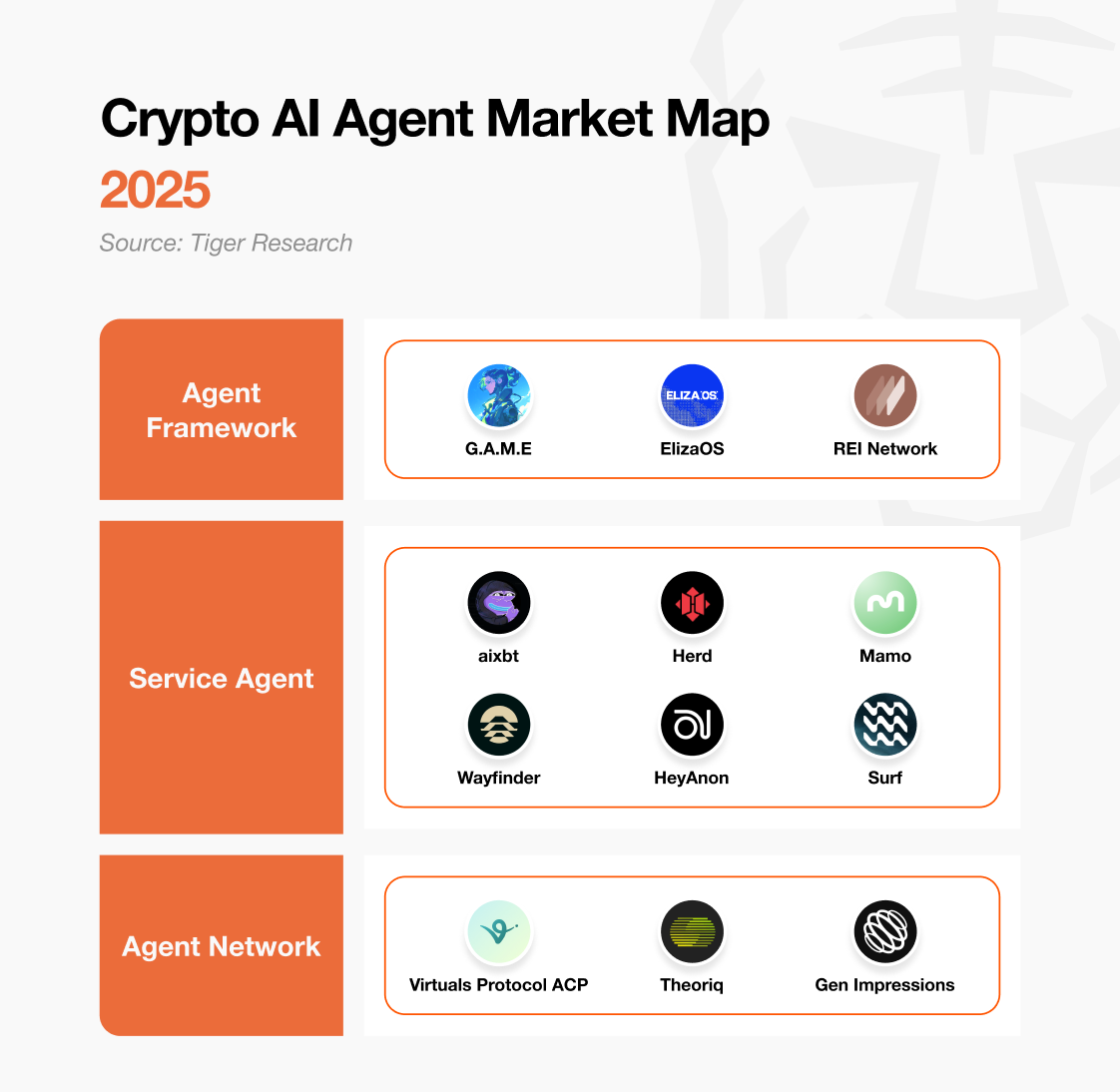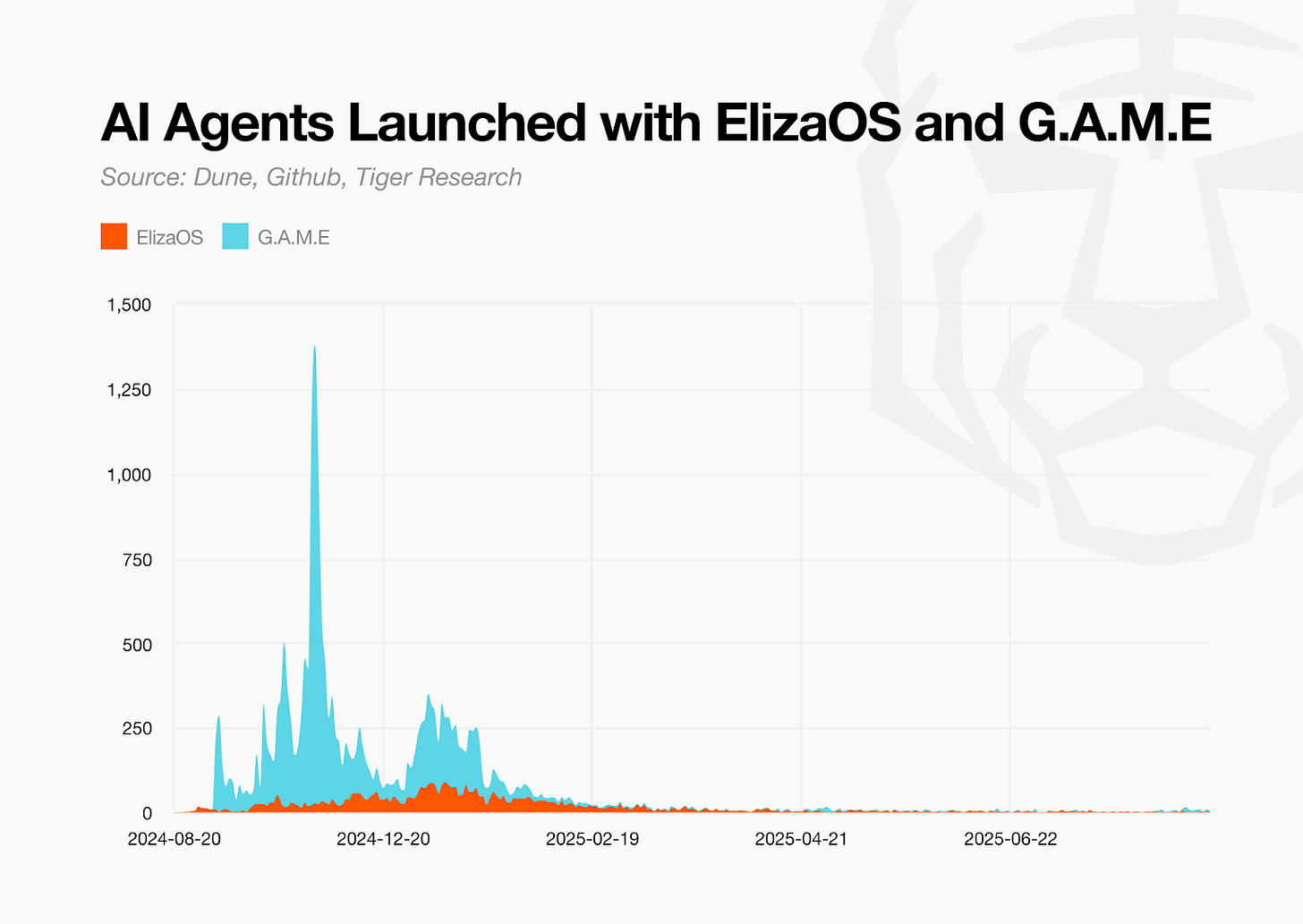AI Agent Market Map: Hype Ends, Technology Continues
TL;DR
- The AI agent market lost momentum after token prices crashed, but technology development continues steadily. The DeFAI sector gains renewed attention through actual product launches and specialized on-chain features.
- Specialized agents optimized for specific functions replace previous general-purpose agents. Projects like Virtuals actively build infrastructure to connect and enable collaboration between these agents.
- AI agents will integrate as core features in crypto projects. Infrastructure that enables smooth communication and cooperation between agents will become critical.
1. Hype Ends, Technology Continues
The crypto industry has integrated AI technology in various ways, with AI agents receiving the most attention. Agent-related tokens once reached a total market cap of approximately $16 billion. This showed intense market interest. This attention was short-lived. Most projects failed to meet development expectations, and token prices crashed over 90% from their peaks.
Price drops do not signal technology regression. AI agents remain an important technical field in crypto. Discussions about practical use cases become more concrete, and teams continue testing new approaches. This report examines how AI agents function within crypto and explores potential future developments.
2. AI Agent Ecosystem Reshapes After the Hype

2.1. Early AI Agent Projects Fade from the Market
The AI agent sector within crypto gained attention starting in late 2024. The ai16z team’s ElizaOS and Virtuals Protocol team’s G.A.M.E development stack significantly lowered the barriers to agent development. Launchpads like DAOS.fun and Virtuals Fun provided platforms to easily tokenize developed agents. The process from development to launch became simplified. Market interest exploded. Numerous agent projects emerged rapidly.

Most projects presented ambitious roadmaps utilizing AI technology. Investors drove up token prices with expectations for innovative services. In reality, these projects were just wrappers around fine-tuned or prompt-engineered OpenAI or Anthropic foundation models. Most projects built advanced chatbots for X or Telegram rather than developing independent services. Projects emphasized innovative visions and technical differentiation, but their actual operations barely differed from memecoins.

Source: aixbt
Some projects were exceptions. Projects like aixbt and Soleng partially achieved their roadmaps and launched actual services. They adopted token gating to provide exclusive access to token holders. Aixbt provided project analysis reports. Soleng analyzed Github repositories to support investor decision-making.
Even these relative success stories could not overcome structural limitations. Unstable revenue structures that depended only on token price increases hindered progress. Technical competitiveness lagged behind Web2 companies. Token prices eventually declined. Operating funds dried up. Most projects have now suspended their services.
2.2. DeFAI Projects Reviving Hope in the Sector
AI agent technology faced excessive expectations that entered a correction phase. The DeFAI sector now gains renewed attention by proving practical value. DeFAI agents execute automated investment strategies 24/7. They enable easy access to complex DeFi services through simple natural language commands. This sector was a core narrative in the early AI agent space. Most projects remained at the roadmap stage and struggled with actual implementation. The sector temporarily lost interest. Recent product launches now rebuild market expectations.
Representative projects include Wayfinder and HeyAnon. Wayfinder performs on-chain tasks through specialized AI agents called “Shells.” Shells execute on-chain transactions directly through built-in dedicated wallets. The system uses specialized multi-agent architecture with transaction agents, perpetual agents, and contract agents. Each agent type focuses on specific roles to automate various investment strategies. Users can easily execute simple cross-chain transactions or advanced strategies like basis trading and leverage DCA.
2.3. Beyond Individual Agents to Agent Networks
Early AI agent projects promoted “general-purpose agents” that performed every function. This approach prioritized capital raising over technical completeness. Projects presented excessive roadmaps to capture broader markets. Most revealed limitations at the execution stage.
The current agent ecosystem moves in a completely different direction. Builders recognize the limitations of general-purpose agents. They now develop agents specialized in specific fields. These agents can collaborate with each other. This resembles skilled craftsmen with different expertise—carpenters, electricians, plumbers—working together to build one house.
Virtuals Protocol’s ACP (Agent Commerce Protocol) represents this trend. It provides a standard framework for communication and task distribution between different agents. Theoriq and General Impression also build infrastructure to enhance interoperability between agents. The market reshapes toward maximizing value for the entire agent ecosystem rather than individual agents.
3. Future Scenarios for the AI Agent Market
AI agents keep developing after the early hype cooled down. Speculation ended, but projects continue building new features and services with AI agents. Two changes stand out.
First, AI agents become essential infrastructure. AI agents are no longer a separate sector but integrate as basic functions of crypto projects. Blockchain data platform Nansen develops research agents to make complex on-chain data easier to explore. DeFi projects also add agents to improve user access. AI agents will become last-mile interfaces connecting users to blockchain, not optional features.
Second, agent commerce will grow. As AI agents become standard, agents will interact more with each other and with people. Secure transaction protocols and trust mechanisms become increasingly important. Projects like Virtuals Protocol’s ACP lay the groundwork for this.
These changes will simplify crypto’s complexity, improve user experience, and create new economic opportunities.
Disclaimer:
- This article is reprinted from [Tiger Research Reports]. All copyrights belong to the original author [Jay Jo)]. If there are objections to this reprint, please contact the Gate Learn team, and they will handle it promptly.
- Liability Disclaimer: The views and opinions expressed in this article are solely those of the author and do not constitute any investment advice.
- Translations of the article into other languages are done by the Gate Learn team. Unless mentioned, copying, distributing, or plagiarizing the translated articles is prohibited.
Related Articles

The Future of Cross-Chain Bridges: Full-Chain Interoperability Becomes Inevitable, Liquidity Bridges Will Decline

Solana Need L2s And Appchains?

Sui: How are users leveraging its speed, security, & scalability?

Navigating the Zero Knowledge Landscape

What is Tronscan and How Can You Use it in 2025?
